Researchers discovered that some of the coldest regions on Earth are the best candidates to apply the benefits of alternative energy coming from the sun, throughout solar panel installations.
The list of unfriendly, cold locations includes the Himalayas and southern Andes. The explanation for this choice is quite simple.
First of all, photovoltaic panels would be able to absorb more sunlight due to the fact that they would be placed at a considerably higher altitude.
Second, it seems that scientists have established that solar cells work more efficiently in cold regions, where temperatures hit lower.
Despite the fact that the scientists don't have actual measurements to prove the degree of degradation for solar panels exposed to high temperatures, they seem to agree upon the fact that heat plays the part of the solar cells' greatest enemy.
Therefore, researchers assume that a colder climate would prolong the life and efficiency of solar panels.
The benefits of using the cold regions' potential for developing alternative sources of energy could represent a profitable business.
Scientists reached the conclusion that by exploiting 4% of the Himalaya’s surface by installing solar panels on approximately 12,000 square kilometers (7,460 square miles) companies could entirely cover China’s demand for electricity.
The benefits of such a project could be overwhelming, since it is known that China is the biggest energy consumer in the entire world. Its demand for energy reached 4,190 Terawatt-hours (Twh) in 2010, compared to the needs of the US, which reached only 3,741 TWh during the same period of time.
This would represent an outstanding achievement for national economies and the market of renewable sources of power.
Nevertheless, the story isn't that simple. It seems that cold regions have also their flaws among their list of advantages regarding the solar energy exploitation.
Some of these areas known for their extreme temperatures also imply the presence of strong winds which might put in danger the integrity of solar panels.
If major projects regarding solar panel installation in such cold regions might turn out to be cost-inefficient, applying the same strategy to small businesses which would provide solar power to rural residents might just become a great way of obtaining profit.

 14 DAY TRIAL //
14 DAY TRIAL //